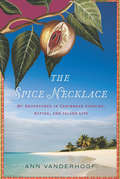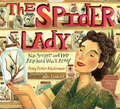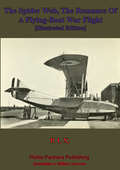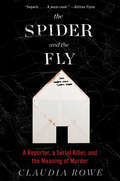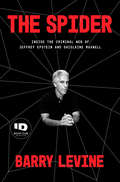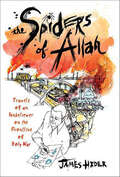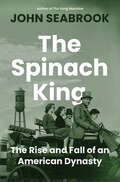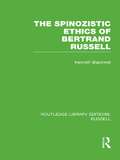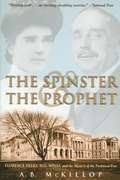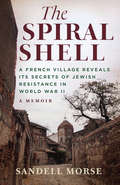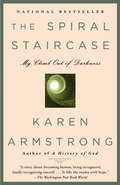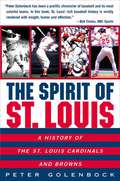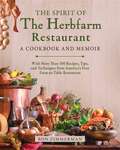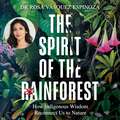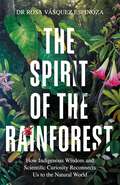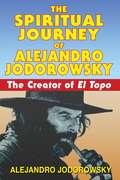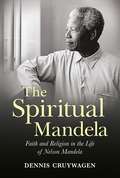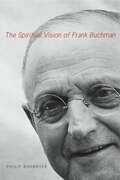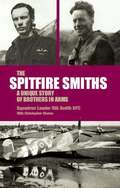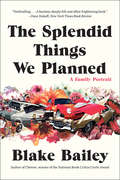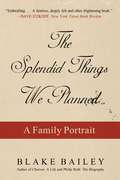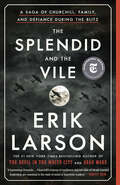- Table View
- List View
The Spice Necklace: My Adventures in Caribbean Cooking, Eating, and Island Life
by Ann VanderhoofThe author of An Embarrassment of Mangoes offers &“a mouthwatering slice of Caribbean culture&” in this blend of travel memoir and cookbook (New York Post). While sailing around the Caribbean, Ann Vanderhoof and her husband Steve track wild oregano-eating goats in the cactus-covered hills of the Dominican Republic, gather nutmegs on an old estate in Grenada, make searing-hot pepper sauce in a Trinidadian kitchen, cram for a chocolate-tasting test at the University of the West Indies, and sip moonshine straight out of hidden back-country stills. Along the way, they are befriended by a collection of unforgettable island characters: Dwight, the skin-diving fisherman who always brings them something from his catch and critiques their efforts to cook it; Greta, who harvests sea moss on St. Lucia and turns it into potent Island-Viagra; sweet-hand Pat, who dispenses hugs and impromptu dance lessons along with cooking tips in her Port of Spain kitchen. Back in her galley, Ann practices making curry like a Trini, dog sauce like a Martiniquais, and coo-coo like a Carriacouan. And for those who want to take these adventures into their own kitchens, she pulls 71 delicious recipes from the stories she tells, which she places at the end of the relevant chapters. The Spice Necklace is a wonderful escape into a life filled with sunshine (and hurricanes), delicious food, irreplaceable company, and island traditions.
The Spider Lady: Nan Songer and her Arachnid World War II Army
by Penny Parker KlostermannPerfect for kids who are fascinated by insects and American history, here is the story of Nan Songer, a little-known hero of World War II, who collected and bred spiders in her home and found new ways to use their silk to help the United States win the war.Venomous spiders, delicate silk, and science experiments filled Nan Songer&’s days and nights—her home in California overflowed with many-legged critters. With inspiration from a friend, Nan began to study how spider silk could be harvested. The finely woven material spiders used to create webs was much stronger than it looked, and Nan was eager to unlock its potential and hopefully help her country at the same time. At the height of WWII, she studied different spiders before landing on the poisonous black widow as the perfect spider to experiment with. Their strong silk could be used for crosshairs on rifles, which Nan used to fill massive orders for the US military. Despite the danger posed by black widows, Nan wasn&’t deterred—she wanted to play her part. Using a device she built for extracting silk, Nan humanely used it on the deadly spiders to get both extra fine and super heavy silk.
The Spider Web, The Romance Of A Flying-Boat War Flight [Illustrated Edition]
by Anon, “P.I.X”"War at sea-war in the air--This is an account of the early days, during the Great War, of the service that became the Fleet Air Arm. It did not take long after hostilities commenced for the Royal Navy to appreciate the potential of an 'air force' both as an eye in the sky and as an effective method of countering enemy surface vessels and most especially German submarine activity. Endurance, speed and surprise were the essential components of the sea-plane and flying boat war. Appearing suddenly out of the sun, a surface cruising U-Boat had little time to dive to safety before destruction rained down upon it. This book contains may gripping incidents of U-Boat hunting in the 'Spider Web', a great tract of the North Sea which was the Navy flyer's patrol area and battlefield. This was a hard war, fraught with dangers from mechanical breakdowns, attacks from enemy aircraft, lethal weather and anti-aircraft fire among its many perils. A riveting account of the sea and early aviation warfare."-Leonaur Print version.Author -- Anon, "P.I.X"Text taken, whole and complete, from the edition published in Edinburgh, W. Blackwood and sons, 1919.Original Page Count - x and 278 pages.Illustrations -- 20 maps and Illustrations.
The Spider and the Fly: A Reporter, a Serial Killer, and the Meaning of Murder
by Claudia Rowe“Extraordinarily suspenseful and truly gut-wrenching. . . . A must-read.”—Gillian Flynn, author of the #1 New York Times bestseller Gone GirlIn this superb work of literary true crime—a spellbinding combination of memoir and psychological suspense—a female journalist chronicles her unusual connection with a convicted serial killer and her search to understand the darkness inside us."Well, well, Claudia. Can I call you Claudia? I’ll have to give it to you, when confronted at least you’re honest, as honest as any reporter. . . . You want to go into the depths of my mind and into my past. I want a peek into yours. It is only fair, isn’t it?"—Kendall FrancoisIn September 1998, young reporter Claudia Rowe was working as a stringer for the New York Times in Poughkeepsie, New York, when local police discovered the bodies of eight women stashed in the attic and basement of the small colonial home that Kendall Francois, a painfully polite twenty-seven-year-old community college student, shared with his parents and sister.Growing up amid the safe, bourgeois affluence of New York City, Rowe had always been secretly fascinated by the darkness, and soon became obsessed with the story and with Francois. She was consumed with the desire to understand just how a man could abduct and strangle eight women—and how a family could live for two years, seemingly unaware, in a house with the victims’ rotting corpses. She also hoped to uncover what humanity, if any, a murderer could maintain in the wake of such monstrous evil. Reaching out after Francois was arrested, Rowe and the serial killer began a dizzying four-year conversation about cruelty, compassion, and control; an unusual and provocative relationship that would eventually lead her to the abyss, forcing her to clearly see herself and her own past—and why she was drawn to danger.
The Spider: Inside the Criminal Web of Jeffrey Epstein and Ghislaine Maxwell
by Barry LevineWho was Jeffrey Epstein? A Pulitzer Prize–nominated journalist unearths never-before-reported details in the most comprehensive account yet of the disgraced financier&’s life, death, and criminal web, including the role of Ghislaine Maxwell. By now, the basic contours of Jeffrey Epstein&’s horrendous crimes—his decades-long serial abuse of young women and underage girls—are familiar. But for all that has been written about Epstein since his shocking death in a lower Manhattan jail cell, an astonishing amount remains unknown. A shy Brooklyn kid turned renegade financier, Jeffrey Epstein never wanted to play by the rules of polite society. He was elusive in life and he has remained just as elusive in death. What is known is that he had amassed nearly $600 million by the time of his death. That fortune allowed Epstein to pursue a privileged, secretive life, jetting between his fortress-like homes in Manhattan, New Mexico, and Little St. James, his private island. Behind these closed doors, Epstein socialized with scientists and world leaders and preyed on powerless young women. In this dogged work of reporting, Barry Levine shines a light into the darkest corners of Epstein&’s world, including • Epstein&’s young adulthood and earliest accusations of sexual misconduct• the murky sources of Epstein&’s fortune and business dealings • Epstein&’s circle of confidantes and employees, particularly the nature of his long relationship with socialite Ghislaine Maxwell• his ties to powerful men, including Bill Clinton, Prince Andrew, Les Wexner, and Donald Trump• Epstein&’s last hours as a free man in Paris and the secret operation to arrest him at a New Jersey airport before he could flee• new details on Epstein&’s final days in jail and the mystery surrounding his death Featuring rare and never-before-seen photographs, The Spider exposes how Epstein operated and evaded justice for so long—and how he drew so many others into his criminal web.
The Spiders of Allah: Travels of an Unbeliever on the Frontline of Holy War
by James HiderIn his fascinating, terrifying and often very funny book, James Hider takes his doubts about religious beliefs straight into the dark heart of the world's holy wars—from Israel to Gaza to Iraq—the birthplace that spawned so many faiths—and then back to Jerusalem. From hardcore Zionist settlers still fighting ancient Biblical battles in the hills of the West Bank to Shiite death squads roaming the lawless streets of Iraq in the aftermath of Saddam; whether it's the misappropriation and martyrdom of Mickey Mouse by Gaza's Islamists, or a US president acting on God's orders, Hider sees the hallucinatory effect of what he calls the 'crack cocaine of fanatical fundamentalism' all around him. As he meets terrorists, suicide bombers, soldiers, ayatollahs, clerics, and ordinary and extraordinary people alike, the question that sparked his journey continues to plague his thoughts: how can people not only believe in this madness, but die and kill for it too? This extraordinary and timely book takes the God Delusion debate onto the streets of the Middle East. It casts an unflinching yet compassionate eye on the very worst and most violent crimes committed in the name of religion, and then sharply asks the questions the world needs to answer if we are ever to stand a chance of facing our own worst demons.
The Spinach King: The Rise and Fall of an American Dynasty
by John SeabrookThe riveting saga of the Seabrook Family, by one of The New Yorker’s most acclaimed storytellers. “Having left this material for his writer son, my father must have wanted the story told, even if he couldn’t bear to tell it himself.” So begins the story of a forgotten American dynasty, a farming family from the bean fields of southern New Jersey who became as wealthy and powerful as aristocrats—only to implode in a storm of lies. The patriarch, C. F. Seabrook, was hailed as the “Henry Ford of Agriculture.” His son Jack, a keen businessman, was poised to take over what Life called “the biggest vegetable factory on earth.” But the carefully cultivated facade—glamorous outings by horse-drawn carriage, hidden wine cellars, and movie star girlfriends—hid dark secrets that led to the implosion of the family business. At the heart of the narrative is a multi-generational succession battle. It’s a tale of family secrets and Swiss bank accounts, of half-truths, of hatred and passion—and lots and lots of liquor. The Seabrooks’ colorful legal and moral failings took place amid the trappings of extraordinary privilege. But the story of where that money came from is not so pretty They say behind every great fortune there is a great crime. At Seabrook Farms, the troubling American histories of race, immigration, and exploitation arise like weeds from the soil. Great Migration Black laborers struck against the company for better wages in the 1930s, and Japanese Americans helped found a “global village” on the farm after World War II. Revealing both C. F. and Jack Seabrook’s corruption, The Spinach King undermines the “great man” theory of industrial progress. It also shows how American farms evolved from Jeffersonian smallholdings to gigantic agribusinesses, and what such enormous firms do to the families whose fate is bound up in the land. A compulsively readable story of class and privilege, betrayal and revenge—three decades in the making—The Spinach King explores the author’s complicated family legacy and the dark corners of the American Dream.
The Spingarn Brothers: White Privilege, Jewish Heritage, and the Struggle for Racial Equality
by Katherine Reynolds ChaddockAn absorbing account of how two Jewish brothers devoted themselves to the struggle for racial equality in the United States.In the late nineteenth century, Joel and Arthur Spingarn grew up in New York City as brothers with very different personalities, interests, and professional goals. Joel was impetuous and high-spirited; Arthur was reasoned and studious. Yet together they would become essential leaders in the struggle for racial justice and equality, serving as presidents of the National Association for the Advancement of Colored People, exposing inequities, overseeing key court cases, and lobbying presidents from Theodore Roosevelt to John F. Kennedy. In The Spingarn Brothers, Katherine Reynolds Chaddock sheds new light on the story of these fascinating brothers and explores how their Jewish heritage and experience as second-generation immigrants led to their fight for racial equality. Upon graduating from Columbia University, Arthur joined a top Manhattan law practice, while Joel became a professor of comparative literature. The two soon witnessed growing racial injustices in the city and joined the NAACP in 1909, its founding year. Arthur began to aim his legal practice toward issues of discrimination, while Joel founded the NAACP's New York City branch. Drawing from personal letters, journals, and archives, Chaddock uncovers some of the motivations and influences that guided the Spingarns. Both brothers served in World War I, married, and pursued numerous interests that ranged from running for Congress to collecting rare books and manuscripts by Black authors around the world. In this dual biography, Chaddock illustrates how the Spingarn brothers' unique personalities, Jewish heritage, and family history shaped their personal and professional lives into an ongoing fight for racial justice.
The Spinozistic Ethics of Bertrand Russell (Routledge Library Editions: Russell)
by Kenneth BlackwellBertrand Russell’s professional philosophical reputation rests mainly on his mathematical logic and theory of knowledge. In this study, first published in 1985, however, Kenneth Blackwell considers Russell’s writings on ethics and metaethics and uncovers the conceptual unity in Russell’s normative ethic. He traces that unity to the influence of Spinoza’s central ethical concept, the ‘intellectual love of God’, and then evaluates the ethic which he terms ‘impersonal self-enlargement’. The introduction discusses the metaethical background to Russell’s ethic and the difficulties inherent in Russell’s view that ethical knowledge is not possible. The first section then examines Russell’s writings on Spinoza from 1894 to 1964, dividing them into three periods, the second part analyzes Russell’s two interpretations of the main concept, traces 'impersonal self-enlargement' in Russell’s own ethical writings, and evaluates the ethic in relation to other ethical theories and on its own merits as a ‘way of living’. This book provides a foundation for a positive re-evaluation of Russell’s status in the major philosophical field of ethics and will be welcomed by students of moral philosophy as well as those interested in Bertrand Russell’s works.
The Spinster and the Prophet: H.G. Wells, Florence Deeks, and the Case of the Plagiarized Text
by A. B. MckillopIn 1920, H. G. Wells published his best-selling The Outline of History. Several years earlier, Florence Deeks had sent a similar work to Wells’s North American publisher. Deeks’s The Web was a history of the world with an emphasis on the role that women played. Her book was rejected. Upon publication of Wells’s massive opus (1,324 pages), which he completed in 18 months, Deeks discovered similarities between the two texts. The books had matching structures, scope, and even contained identical factual errors. From accounts of their contrasting lives (Wells was a philanderer and social progressive, and Deeks was a feminist who never married), personal memoirs, and courtroom transcripts — where Deeks fought her case of plagiarism — McKillop weaves the story like a legal thriller.
The Spiral Shell: A French Village Reveals Its Secrets of Jewish Resistance in World War II
by Sandell MorseApril 2020 will mark the 80th Anniversary of the fall of France to Nazi Germany, and the establishment of the provisional government of the Vichy state, a puppet of the Axis regime, to carry out the arrest and deportation of all Jewish civilians. In the course of her writing residency over a three-year period in the village of Auvillar, the author learns of acts of bravery and rebellion on the part of several of the Jewish families and individuals who risked their lives to save innocent refugees and children orphaned by the Holocaust, and gradually gains their trust enough for them to share the details of their harrowing experiences of rebellion and resistance. The author in turn discovers truths about her own life and Jewish heritage in America, which she now sees in the light of the bravery and selflessness of those who elected to act and not stand by idly in the face of oppression and genocide.
The Spiral Staircase
by Karen ArmstrongThe moving story of her own search for God by the highly-acclaimed author of the bestselling A History of God: The 4,000-Year Quest of Judaism, Christianity and Islam; The Battle for God: A History of Fundamentalism; and Islam: A Short History. In 1969, after seven years as a Roman Catholic nun -- hoping, but ultimately failing, to find God -- Armstrong left her convent. She knew almost nothing of the changed world she was entering, and she was tormented by panic attacks and inexplicable seizures. Her struggle against despair was fueled by a string of discouragements -- failed spirituality, doctorate and jobs, fruitless dealings with psychiatrists -- but finally, in 1976, she was diagnosed with epilepsy and given proper treatment. She then began the writing career that would become her true calling, and as she focused on the sacred texts of Judaism, Christianity and Islam, her own true inner story began to emerge. She would come to experience brief moments of transcendence through her work -- the profound fulfillment that she had not found in the long hours of prayer as a young nun. Powerfully engaging, often heart-breaking, but lit with bursts of humour, The Spiral Staircase is an extraordinary history of self.
The Spirit of St. Louis: A History of the St. Louis Cardinals and Browns
by Peter GolenbockNo metropolis in America has more pure baseball spirit than St. Louis, Missouri. It's a love affair that began in 1874, when a band of local boosters raised $20,000 to start a professional ball club, and the honeymoon still isn't over. Now Peter Golenbock, the bestselling author and master of baseball oral history, has written another remarkable saga enriched by extensive and incomparable remembrances from the scores of players, managers, and executives who lived it.These pages capture the voices of Branch Rickey on George Sisler. Rogers Hornsby and his creation of the farm system. Hornsby on Grover Cleveland Alexander -- and Alexander on Hornsby. Dizzy Dean on -- who else? -- Dizzy Dean. And so many others including "The Man" himself, Stan Musial; Eldon Auker, Ellis Clary, Denny Galehouse, and Don Gutteridge on the 1940s Browns; Brooks Lawrence, the second man to cross the Cardinals' color line; Jim Bronsnan, the first man to break the players' "code of silence"; Tommy Herr, Darrell Porter, and Joe McGrane on Whitey Herzog's Cardinals; and Cardinal owner Bill DeWitt, Jr., on the team today.
The Spirit of The Herbfarm Restaurant: A Cookbook and Memoir: With More Than 100 Recipes, Tips, and Techniques from America's First Farm-to-Table Restaurant
by Ron ZimmermanThis book brings together more than 100 unique recipes from and inspired by America&’s first true &“farm-to-table&” restaurant with the story of its creation. Working together, founders Ron Zimmerman and Carrie Van Dyck turned a farm garage into a restaurant like no other. In their pre-opening manifesto, they vowed to use only local ingredients to reunite their guests with the increasingly forgotten nature that has sustained us for hundreds of years. The initial offering was a single noon seating that began with a garden tour led by Carrie. This quickly became a nine-course chef-selected menu with a price that included wine pairings. The meals told a daily story in six or nine sequential dishes of what was in the garden, wilds, farm, and sea. Unlike restaurants that would later cloak themselves in the verbal mantle of &“farm-to-table,&” The Herbfarm Restaurant first found the food and only then designed the menu. Everything in each dish was local, not just the protein or main vegetable. Even olive oil and lemons weren&’t used in the first years until Oregon olive orchards blossomed. There were no &“supplements&” or extra charges. Since guests were charged in advance, they knew to the penny what the experience would cost. Part memoir, part cookbook, The Spirit of the Herbfarm Restaurant is a walk down memory lane, written, photographed, and largely designed by Ron before his death in 2023. Delight in the history of the restaurant as well as the unique seasonal dishes and recipes and beautiful photography that cover all occasions.
The Spirit of the Rainforest: How Indigenous Wisdom Reconnects Us to Nature
by Dr Rosa Vásquez EspinozaBefore you step into the jungle, there are a few things you need to know...Join scientist Dr Rosa Vasquez Espinoza as she uncovers one of the most unexplored regions on the planet.Dr Rosa is no stranger to the Amazon. Growing up with the rainforest as her back garden, she learnt the lessons of the rainforest from her grandmother, a native healer in natural medicine. She went on to pursue a classical education in science, gaining a PhD in the US, but has always been pulled back to the heart of the Amazon. As a leading biologist in her field, Rosa continues to explore the region through a unique blend of scientific inquiry and ancient insight.In this debut, you'll learn about Dr Rosa's journeys in the Amazon: her treacherous encounters with a boiling river, her conservation work with stingless bees, her experience of taking ayahuasca as a natural psychedelic - and all the amazing biodiversity of the rainforest. At the heart of Rosa's expedition is her passion to combine science with the indigenous knowledge of the Amazon. She shares her experience of learning from the indigenous communities that she visits, and shows what they have to teach us - stretching beyond the realm scientific knowledge. Here Rosa learns the most important lessons in how to reconnect to the natural world - and, in turn, will teach us to do the same.In this book, Rosa celebrates the richness of Amazonian culture, the wonders of biodiversity, and the enduring spiritual connections between humanity and the natural world.
The Spirit of the Rainforest: How indigenous wisdom and scientific curiosity reconnects us to the natural world
by Dr Rosa Vásquez EspinozaBefore you step into the jungle, there are a few things you need to know...Join scientist Dr Rosa Vasquez Espinoza as she uncovers one of the most unexplored regions on the planet.Dr Rosa is no stranger to the Amazon. Growing up with the rainforest as her back garden, she learnt the lessons of the rainforest from her grandmother, a native healer in natural medicine. She went on to pursue a classical education in science, gaining a PhD in the US, but has always been pulled back to the heart of the Amazon. As a leading biologist in her field, Rosa continues to explore the region through a unique blend of scientific inquiry and ancient insight.In this debut, you'll learn about Dr Rosa's journeys in the Amazon: her treacherous encounters with a boiling river, her conservation work with stingless bees, her experience of taking ayahuasca as a natural psychedelic - and all the amazing biodiversity of the rainforest. At the heart of Rosa's expedition is her passion to combine science with the indigenous knowledge of the Amazon. She shares her experience of learning from the indigenous communities that she visits, and shows what they have to teach us - stretching beyond the realm scientific knowledge. Here Rosa learns the most important lessons in how to reconnect to the natural world - and, in turn, will teach us to do the same.In this book, Rosa celebrates the richness of Amazonian culture, the wonders of biodiversity, and the enduring spiritual connections between humanity and the natural world.
The Spirit of the Rainforest: How indigenous wisdom and scientific curiosity reconnects us to the natural world
by Dr Rosa Vásquez EspinozaBefore you step into the jungle, there are a few things you need to know...Join scientist Dr Rosa Vasquez Espinoza as she uncovers one of the most unexplored regions on the planet.Dr Rosa is no stranger to the Amazon. Growing up with the rainforest as her back garden, she learnt the lessons of the rainforest from her grandmother, a native healer in natural medicine. She went on to pursue a classical education in science, gaining a PhD in the US, but has always been pulled back to the heart of the Amazon. As a leading biologist in her field, Rosa continues to explore the region through a unique blend of scientific inquiry and ancient insight.In this debut, you'll learn about Dr Rosa's journeys in the Amazon: her treacherous encounters with a boiling river, her conservation work with stingless bees, her experience of taking ayahuasca as a natural psychedelic - and all the amazing biodiversity of the rainforest. At the heart of Rosa's expedition is her passion to combine science with the indigenous knowledge of the Amazon. She shares her experience of learning from the indigenous communities that she visits, and shows what they have to teach us - stretching beyond the realm scientific knowledge. Here Rosa learns the most important lessons in how to reconnect to the natural world - and, in turn, will teach us to do the same.In this book, Rosa celebrates the richness of Amazonian culture, the wonders of biodiversity, and the enduring spiritual connections between humanity and the natural world.
The Spiritual Mandela: Faith and Religion in the Life of Nelson Mandela
by Dennis CruywagenIn the first book of its kind, an acclaimed South African journalist and former parliamentary spokesperson for the ANC shares how Nelson Mandela balanced his Christian faith with his political views, exploring how the beloved leader reconciled his own beliefs with the hard truth that religion had often been used as a tool to oppress his people. ♦ "Insightful. . . a nuanced understanding of how faith influenced the renowned civil rights activist." — Publishers Weekly, starred review ". . .illuminating and an essential addition to studies of Mandela's life and work." —Booklist Nelson Mandela revealed nothing about his personal religious beliefs in his writings or in his public pronouncements. But those who were close to him know that he held Christian views. At his request, the final components of his funeral followed the Methodist service. Acclaimed journalist Dennis Cruywagen traces the spiritual component of Mandela's life, from his youth in a traditional Thembu village to his education at Wesleyan and Methodist mission schools to his time as an activist to his period on Robben Island and the years thereafter. Based on interviews with some of Mandela's close colleagues, such as Ahmed Kathrada, as well as priests and other religious figures with whom he interacted, this book unearths an unknown dimension of one of recent history's most respected men.
The Spiritual Vision of Frank Buchman
by Philip BoobbyerThe Spiritual Vision of Frank Buchman is an in-depth look at the life, spirituality, and ideology of one of the most original figures in twentieth-century religion. Frank Buchman (1878–1961), the Pennsylvania-born initiator of the movement known as the Oxford Group and Moral Re-Armament, was a Lutheran pastor who first had influence as a college evangelist and missionary with the YMCA. His thinking then evolved during the 1930s, the Second World War, and the early Cold War as he tried to develop a world philosophy that could offer an answer to war and materialism. His impact was particularly felt in the areas of conflict resolution between nations and interfaith dialogue, and Alcoholics Anonymous also owed much to his methods. Philip Boobbyer’s book is the first scholarly overview of Buchman’s ideas and is an important addition to the growing corpus of academic literature on his worldwide outreach. Boobbyer shows how his work reflected broader processes in twentieth-century religion and politics and can be seen as a spiritual response to an emerging global society.
The Spiritual Vision of Frank Buchman
by Philip BoobbyerThe Spiritual Vision of Frank Buchman is an in-depth look at the life, spirituality, and ideology of one of the most original figures in twentieth-century religion. Frank Buchman (1878–1961), the Pennsylvania-born initiator of the movement known as the Oxford Group and Moral Re-Armament, was a Lutheran pastor who first had influence as a college evangelist and missionary with the YMCA. His thinking then evolved during the 1930s, the Second World War, and the early Cold War as he tried to develop a world philosophy that could offer an answer to war and materialism. His impact was particularly felt in the areas of conflict resolution between nations and interfaith dialogue, and Alcoholics Anonymous also owed much to his methods. Philip Boobbyer’s book is the first scholarly overview of Buchman’s ideas and is an important addition to the growing corpus of academic literature on his worldwide outreach. Boobbyer shows how his work reflected broader processes in twentieth-century religion and politics and can be seen as a spiritual response to an emerging global society.
The Spitfire Smiths: A Unique Story of Brothers in Arms
by Christopher Shores Rod SmithA posthumous autobiography, culled from a partial manuscript and notes, by Canada&’s World War II fighter ace and his equally heroic brother. In late 2001 Rod Smith died tragically at his own hand, leaving behind a part-written autobiography and many notes. His friend, the historian Christopher Shores, took on the task of seeking to complete the story as nearly as possible to how he believed Rod had wished it to be. Rod and his brother Jerry both became Spitfire pilots during World War II, leaving their home in Canada only to find themselves—purely by chance—serving together in the defense of Malta during 1942. Jerry had already gained some fame as the first pilot ever to land a Spitfire on an aircraft carrier. Both showed immediate promise as fighter pilots, but by the end of that year Jerry was dead—last seen chasing a German bomber out to sea—while Rod had become an &“ace&” and would receive the D.F.C. Two years later, serving as a squadron commander in Western Europe, he claimed six Messerschmitts down within a single week, and was involved in the shooting down of the first German jet aircraft to fall to British Commonwealth fighters. He ended the war as one of Canada&’s highest scoring aces, with more than 13 victories to his credit. After the war, he qualified as both an aeronautical engineer and a barrister. His untimely death was a great loss not only to his family and friends, but to the wider world of aviation history as well. This book, containing many diary entries from each of the brothers, is a testament to them.
The Splendid Things We Planned: A Family Portrait
by Blake BaileyA National Book Critics Circle Award Finalist 'Autobiography' The renowned biographer's unforgettable portrait of a family in ruins--his own. Meet the Baileys: Burck, a prosperous lawyer once voted the American Legion's "Citizen of the Year" in his tiny hometown of Vinita, Oklahoma; his wife Marlies, who longs to recapture her festive life in Greenwich Village as a fetching young German immigrant, fresh off the boat; their addled son Scott, who repeatedly crashes the family Porsche; and Blake, the younger son, trying to find a way through the storm. "You're gonna be just like me," a drunken Scott taunts him. "You're gonna be worse." Winner of the National Book Critics Circle Award and finalist for the Pulitzer Prize, Blake Bailey has been hailed as "addictively readable" (New York Times) and praised for his ability to capture lives "compellingly and in harrowing detail" (Time). The Splendid Things We Planned is his darkly funny account of growing up in the shadow of an erratic and increasingly dangerous brother, an exhilarating and sometimes harrowing story that culminates in one unforgettable Christmas.
The Splendid Things We Planned: A Family Portrait
by Blake BaileyA National Book Critics Circle Award Finalist 'Autobiography' The renowned biographer&’s unforgettable portrait of a family in ruins—his own. Meet the Baileys: Burck, a prosperous lawyer once voted the American Legion&’s &“Citizen of the Year&” in his tiny hometown of Vinita, Oklahoma; his wife Marlies, who longs to recapture her festive life in Greenwich Village as a pretty young German immigrant, fresh off the boat; their addled son Scott, who repeatedly crashes the family Porsche; and Blake, the younger son, trying to find a way through the storm. &“You&’re gonna be just like me,&” a drunken Scott taunts him. "You&’re gonna be worse." Winner of the National Book Critics Circle Award and finalist for the Pulitzer Prize, Blake Bailey has been hailed as "addictively readable" by the New York Times and praised for his ability to capture lives "compellingly and in harrowing detail" by Time. The Splendid Things We Planned is his darkly funny account of growing up in the shadow of an erratic and increasingly dangerous brother, an exhilarating and sometimes harrowing story that culminates in one unforgettable Christmas.
The Splendid and the Vile: A Saga of Churchill, Family, and Defiance During the Blitz
by Erik Larson#1 NEW YORK TIMES BESTSELLER • The author of The Devil in the White City and Dead Wake delivers an intimate chronicle of Winston Churchill and London during the Blitz—an inspiring portrait of courage and leadership in a time of unprecedented crisis &“One of [Erik Larson&’s] best books yet . . . perfectly timed for the moment.&”—Time • &“A bravura performance by one of America&’s greatest storytellers.&”—NPR NAMED ONE OF THE BEST BOOKS OF THE YEAR BY The New York Times Book Review • Time • Vogue • NPR • The Washington Post • Chicago Tribune • The Globe & Mail • Fortune • Bloomberg • New York Post • The New York Public Library • Kirkus Reviews • LibraryReads • PopMattersOn Winston Churchill&’s first day as prime minister, Adolf Hitler invaded Holland and Belgium. Poland and Czechoslovakia had already fallen, and the Dunkirk evacuation was just two weeks away. For the next twelve months, Hitler would wage a relentless bombing campaign, killing 45,000 Britons. It was up to Churchill to hold his country together and persuade President Franklin Roosevelt that Britain was a worthy ally—and willing to fight to the end. In The Splendid and the Vile, Erik Larson shows, in cinematic detail, how Churchill taught the British people &“the art of being fearless.&” It is a story of political brinkmanship, but it&’s also an intimate domestic drama, set against the backdrop of Churchill&’s prime-ministerial country home, Chequers; his wartime retreat, Ditchley, where he and his entourage go when the moon is brightest and the bombing threat is highest; and of course 10 Downing Street in London. Drawing on diaries, original archival documents, and once-secret intelligence reports—some released only recently—Larson provides a new lens on London&’s darkest year through the day-to-day experience of Churchill and his family: his wife, Clementine; their youngest daughter, Mary, who chafes against her parents&’ wartime protectiveness; their son, Randolph, and his beautiful, unhappy wife, Pamela; Pamela&’s illicit lover, a dashing American emissary; and the advisers in Churchill&’s &“Secret Circle,&” to whom he turns in the hardest moments. The Splendid and the Vile takes readers out of today&’s political dysfunction and back to a time of true leadership, when, in the face of unrelenting horror, Churchill&’s eloquence, courage, and perseverance bound a country, and a family, together.
